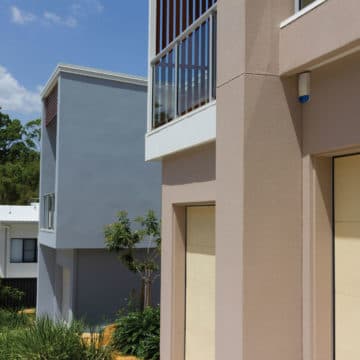To ensure that you get the best results of your render for as long as possible, it is essential that you clean the area properly. Unlike many other cement-based products, the maintenance of rendering systems is quite easy and often only requires household products. With regular upkeep, the rendered coatings will have a longer and more trouble-free life!
Here at RSA, we recommend periodic cleaning of the area every 6-12 months. If this schedule is maintained, it may alleviate the need to use harsh and dangerous solvents or acid-based cleaners on the surface of the render.
Hand cleaning
When it comes to cleaning render, one easy way to achieve great results is hand cleaning. This can be done by scrubbing the surface with a stiff broom and hosing it down as you go. By doing this, you will avoid a film of dry grime and residue from developing, which once formed, can be more difficult to remove.
It is important to note that hand cleaning is not recommended for RSA Bling finishes. We would recommend the use of a soft-bristled brush in place of a stiff broom.
Pressure cleaning
If you are wanting to use a pressure cleaner to wash your render, there are a few recommendations to avoid lifting of the rendered finish. Only use a pressure cleaner with a fan tip, instead of a needlepoint, and spray at 80-120Psi. It is also advised to keep the pressure cleaner at a reasonable distance from the surface area. We would say a distance of around 200mm/ 20cm.

Cleaning fluids
When using cleaning fluids to wash your surface, most generic household cleaners are safe for general cleaning, provided all safety precautions are followed.
CCS Citric cleaner is an excellent product to maintain your render. CCS Citric Cleaner is low VOC (low in fumes) and is biodegradable and is effective in removing grease, oil and efflorescence. If you are having issues with stains such as rust, the best method for removing it is to use tweezers or a knife to remove the rust particle and then use CLR Cleaner.
Mould and mildew
Mould and mildew grow in areas that have high levels of humidity, with condensation and in spots where water leaks occur. When mould spores settle on a coated surface, such as render, they hatch out and draw nourishment from the coating or the dirt on the surface. Because of the spores that are produced by mould, they will continue to grow even if it appears to have been removed.
If this does occur on your surface, it is important to apply a residual fungicidal wash like Acryloc Mould Rid, available at RSA. The Mould Rid will remain on the surface and kill mould as it hatches from the spores if your surface is frequently exposed to moisture and or humidity.
Through regular maintenance of your rendered area, longevity of your surface can be upheld. This article aimed to highlight the different methods of maintenance that should be followed for your area. If you require any further assistance, please get in contact with us.





